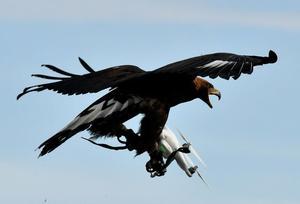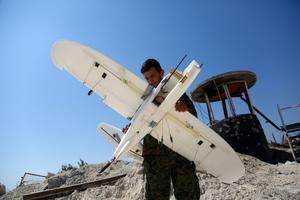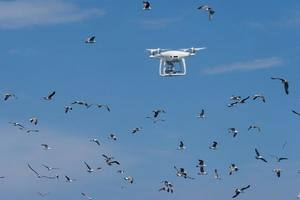A recent interview on The Verge.com with retired United States Navy Captain John E Jackson, a professor at the Naval War College, outlines the current state of play with drains in general, and some of the more unexpected military ramifications. Jackson says in effect that drones are basically reshaping all areas of warfare, providing working options for everything from aerial long-range drones to undersea drones, and even full size unmanned ships.
This interview is well worth reading as a clear outline of many of the new emerging issues with the deployment of drones by the military. For example, did you know that PTSD among drone operators is a real thing? I’m not going to regurgitate the interview, but I do strongly recommend that you read it in full, to see exactly how complex the drone situation is getting.
Artificial intelligence and drones
A new element, so new that it is not yet operational but is an obvious ramification is the issue of artificial intelligence-operated drones. Capt. Jackson states that under US guidelines, human beings are supposed to be involved in the operation of automated systems. That, however, doesn’t quite mesh with the fact that all technology can have problems in operation, and exactly how a human would manage an artificial intelligence malfunction is anything but clear.
Something to look forward to, no doubt, but at what point do these systems become virtually autonomous? The push against automated military systems, a.k.a. the Campaign To Stop The Killer Robots, may find some very blurry definitions here.
The simple fact is that most military combat systems are now so technology-heavy that the distinction between semi autonomous and autonomous air is really a matter of who’s controlling what at any given moment. Second generation fighters, for example, a.k.a. “fly by wire” simply cannot be operated entirely by human beings anymore. There are too many systems, too many combat variables, and a literal tonnage of technologies on every plane. In theory, these planes are not autonomous, but a lot of their functions are automatic.
The corollary here is that weaponised drones, which are now, (usually incorrectly), being equated with conventional military aircraft, are also taking on many of the same technologies. In effect, an unmanned drone, with six generation technology, is virtually autonomous, with human input much more peripheral.
If that sounds dangerous, it is. Human error is one thing; machine error, on the other hand, could be catastrophic, and quite literally happen automatically. You can forget the fear mongering and a science-fiction horror stories. These are real practical issues, and it only takes a couple of switches to be off or on to trigger god knows what.
“Friendly fire” could quite literally turn in to a “friendly massacre” at the flip of a switch. (Yes, there are well-established means of avoiding friendly targeting, provided those methods work in real combat operations. If they don’t, things could get very ugly.)
The next wave of drones
The next generation of drones could include everything from hypersonic drones to Nano drones, in any range of forms with any type of weapons system that can be mounted on them. The stakes will be further raised by more advanced weapons, too. Drone combat has a somewhat misleading image of being a simple flying, fire and forget operation. Remote controlled drones can quite literally roam the world, seeking out targets and hitting them. It doesn’t necessarily follow that all operations will be that simple, particularly against air defences, other drones, with or without target acquisition issues and other routine problems.
OK. The next stage in this evaluation is much less simple. Drones with advanced weapons, like cruise missiles, micro nuclear weapons, area weapons, antipersonnel devices, etc., come with added risks. The chances of increased civilian casualties, collateral damage, and a wide range of militarily worthless added problems increase accordingly.
Even the theory of “nice” warfare doesn’t stack up too well against these real problems. The practice is likely to be absurd. After the event, thousands of human casualties caused by a malfunctioning machine, aren’t “war crimes” they are inevitable, hideous, mistakes.
That creates a much less obvious set of problems. Imagine a whole range of weapons systems where any number of atrocities can be blamed on malfunctioning machines. Imagine automated genocide, and you may just glimpse the picture. Imagine selective strikes against civilian demonstrators, in which someone is miraculously incinerated by some high yield automated weapon.
Drones are here to stay as military weapons for the foreseeable future. There is no doubt at all about that. Drones can be used as air superiority weapons, air denial weapons, airborne minefields, and for a vast range of tactical and strategic operations.
Drones, in fact, are big business in the military industrial complex, and that is pretty much the whole story in terms of debating whether or not they are used. Drones are also scalable, and can come in any size from toy car size to literally the size of a destroyer. They can carry any kind of weapon, anywhere. National defence has literally no choice but to use drones, if only to counter drones.
The questions are these:
• What possible safeguards are there to ensure that conventional and automated drones can be properly controlled and prevented from becoming major liabilities to their users?
• Where you draw the line between autonomous drones and semi-autonomous?
• At what point do drones become a potential liability to the military?
There’s a parallel here that needs to be mentioned. When tanks were invented, the idea was that they would save lives, reduce the risk of casualties, and provide massive extra combat capacity. To this day, tanks are still in the picture. Anything that can be fired at a tank can usually be fired by a tank. Additional defence systems have made tanks once again much less vulnerable to countermeasures.
The same will probably be true of drones. It’s really not at all hard to visualise a drone with the capacities of a next-generation fighter, for example. The problem is that these weapons will create a type of warfare which could quite literally hit anywhere on earth, at any time, with or without human operators.
Let’s just hope that somebody is minding the store with good ideas how to handle all these possible situations, because the whole idea of warfare has just become a lot trickier.
This opinion article was written by an independent writer. The opinions and views expressed herein are those of the author and are not necessarily intended to reflect those of DigitalJournal.com
 Unmanned Aerial Vehicle The latest drone news
Unmanned Aerial Vehicle The latest drone news





